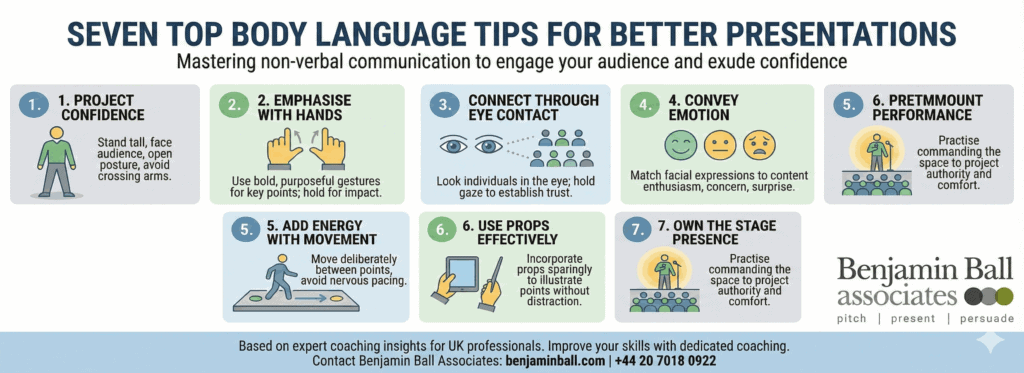
Seven Top Body Language Tips for Better Presentations
November 29, 2023
Updated December 2025
What does good body language look like in a presentation? How do you develop positive body language when presenting? How do you use body language to enhance a presentation? How do you use body language in public speaking?
Better Body Language is a Key Presentation Skill
Good body language is your best visual aid. Long before you speak your first word, your audience has already judged your confidence, credibility and capability.
When you master body language in presentations—your posture, hands, eye contact, and movement—you transform from a speaker into a leader. You come across as clear, convincing and worth listening to. Conversely, ignoring your presentation body language can result in bad habits that detract from even the best content.
Drawing on over 15 years of coaching CEOs and senior executives at Benjamin Ball Associates, here are our top body language tips and body language examples to help you win your audience.

Meet the Author: Benjamin Ball
Ben is the founder of Benjamin Ball Associates and leads the presentation coaching and pitch deck creation teams. Formerly a corporate financier in the City of London, for 20+ years he’s helped businesses win with better pitches and presentations, particularly investor pitches. He is a regular speaker and a guest lecturer at Columbia Business School and UCL London. Follow Ben on LinkedIn or visit the contact page.
Why Good Body Language Matters When Presenting
When you speak, your audience pays as much attention to your non-verbal signals as your words. Body language in a presentation serves three distinct roles:
- Replaces speech (e.g., a nod).
- Reinforces speech (e.g., gesturing while emphasising a point).
- Reveals true feelings (e.g., fidgeting when nervous).
Successful speakers use open, controlled gestures. If your body language when presenting suggests nervousness, the audience interprets this as a lack of confidence. To transfer energy and enthusiasm, you need to command the space with a powerful body language presentation style.
7 Actionable Good Body Language Tips for Presentations
1. Stand Proud When Presenting
Knowing how to stand when presenting is the foundation of effective delivery. A strong stance projects authority and helps you breathe properly. Don’t make the mistake of standing diagonally, half facing the audience and half looking at the screen.
- The Stance: Stand tall with your feet shoulder-width apart. Keep your weight evenly balanced and face the audience fully. This is the gold standard for how to stand when public speaking.
- The Upper Body: Keep your arms and shoulders relaxed. Avoid crossing your arms, as this makes you appear defensive.
- Learn From Actors: An old acting adage is “shoulders back, chest out”
The Drill: Try delivering the first 30 seconds of your talk without moving your feet. This improves your body posture in presentation scenarios and signals that you are grounded.
2. Use Your Hands to Emphasise Points
“What should I do with my hands?” is the most common question we hear regarding body language tips for presentation success.
- The “Ready” Position: When you aren’t gesturing, hold your hands slightly in front of you with bent elbows. It may feel odd at first, but it is good body language that looks natural to the audience.
- Purposeful Gestures: Use your hands to emphasise key points. Gestures above shoulder height add energy (great for large stages), while lower gestures can feel more conversational.
- Avoid the “Flap”: Lots of tiny, nervous movements make you look smaller. Go for big, bold, purposeful gestures that you hold for a few seconds.
- As a rule of thumb, the bigger your audience, the bigger your gestures need to be.
EXAMPLE: Jill Bolte’s TED talk demonstrates this well.
3. Master the Art of Eye Contact
Good eye contact creates a connection. We trust people who can “look us in the eye.” To use this effectively, you must avoid scanning the room too quickly or staring at your notes. And you must avoid looking at the screen or PowerPoint slides.
The “One Thought” Rule:
- Only talk when you are looking at someone.
- Spend one or two sentences talking to a specific person to get some “quality time” with them.
- Hold that contact until the end of the sentence, then move to another person in a different part of the room.
If you are nervous about direct eye contact, look at their forehead or nose—from the stage, they won’t know the difference.
4. Facial Expressions: Match Your Message
Your face is the primary emotional indicator for your audience. If your content is exciting, your face should show enthusiasm. If the content is serious, your expression should reflect concern.
- The Disconnect: We often see speakers delivering good news with a flat, “poker face.” This confuses the audience.
- The Fix: Practice in front of a mirror or record yourself. You often need to be more expressive than you think to ensure the emotion reaches the back of the room.
Watch Ken Robinson to see how effective facial expressions can be.
5. Movement: Add Energy, Not Distraction
Movement is a powerful tool for body language while presenting, but it must be deliberate.
- The “Countryside Walk”: Aim to emulate a pleasant walk from viewpoint to viewpoint. Make a point, move to another part of the stage, plant your feet, and make your next point.
- Avoid Pacing: Pacing back and forth makes a speaker look distressed.
- Stillness is Power: Aim to stand still for the majority of your talk. Controlling your body language during a presentation conveys supreme confidence.
6. Tailor Body Language for Virtual Presentations
In the era of Zoom and Teams, body language in presentation environments has shifted. The screen reduces your presence, so you must work harder to connect.
- Eye Contact: Look directly into the camera lens, not at the faces on your screen. This simulates eye contact for the viewer.
- Framing: Sit up straight and frame yourself from the mid-torso up so your hand gestures are visible.
- Energy: You need to put about 20% more energy into your performance to break through the “digital barrier.”
7. Practice Self-Awareness (Don’t “Just Act Natural”)
Advice to “just act natural” is useless. Being watched by a crowd isn’t a natural situation. To improve your presentation skills body language, you must become aware of your unconscious habits.
- Record Yourself: Film a 2-minute section of your talk. Watch it back with the sound off. You will instantly spot fidgeting or repetitive gestures.
- Get Feedback: Ask a friend or colleague to point out every time your eye contact drops. Body language in presentation skills training is often about unlearning these bad habits first.
When we coach our clients, we regularly use video recordings to help improve body language quickly.
The “Secret” to Good Body Language: Content First
If your presentation content is weak or unstructured, even the best body language for presentations won’t save you. Conversely, if you know your message is clear and powerful, your physical confidence will naturally increase.
At Benjamin Ball Associates, our coaching philosophy works on getting the foundation right first:
- Clear Message: We make sure you have a sharp, persuasive argument.
- Subtle Structure: We build a flow that guides the audience.
- Powerful Language: We refine your words for maximum impact.
Once these are in place, polishing your body language becomes significantly easier.
Case Study: How Strong Body Language Transformed Analyst Perception
A major European supermarket group had great news for shareholders, yet its CEO struggled to win confidence. The numbers were solid, but his presence in the room told a different story.
When he presented results, he kept his eyes fixed on a script. He rarely smiled. His answers felt short and, at times, defensive. His body language suggested hesitation rather than confidence.
What we worked on
When he came to us, he was unclear how to look like the powerful leader leader he was. We helped him:
- Tighten and simplify his equity story
- Use notes without appearing scripted
- Bring warmth into the room through simple behaviours such as smiling and pausing
- Hold himself in a way that projected calm authority
- Answer challenging questions without slipping into curt responses
During rehearsals, he practised standing with a grounded stance, lifting his gaze and shaping his gestures so he looked open rather than closed. Small changes made a big difference to how others read him.
The result
At his next results presentation, the shift was noticeable. He looked composed, spoke with clarity and handled questions with ease. Analyst concerns faded. The board stopped hearing worries about his leadership, and he stayed in post with stronger support than before.
He still works on his skills every year, building on what he learned. His growing executive presence now matches the success of the company, which continues to perform exceptionally well.
If you want your message to land, your body language is part of the story. This CEO’s experience shows how quickly perceptions can change when you take control of it.
Transform Your Presentation Skills Today
Developing executive presence is a learned skill. Over the last 15+ years, our award-winning team has helped thousands of CEOs, senior executives and business leaders deliver impressive pitches and speeches.
“I honestly thought it was the most valuable 3 hours I’ve spent with anyone in a long time.”
— Mick May, CEO, Blue Sky
Ready to stand out?
We can transform your presenting skills and your body language in as little as a few hours. We offer in-house training, one-to-one executive coaching, and investor pitch preparation.
Call Louise Angus, our client services director on +44 20 7018 0922 or email her on info@benjaminball.com. Or click the button below and we’ll get back to you very quickly.
Speak to an expert. Get a free consultation
Why Choose Us:
Transform your pitches and presentations with tailored coaching

We can help you present brilliantly. Thousands of people have benefitted from our tailored in-house coaching and advice – and we can help you too.
“I honestly thought it was the most valuable 3 hours I’ve spent with anyone in a long time.”
Mick May, CEO, Blue Sky
For 15+ years we’ve been the trusted choice for leading businesses and executives throughout the UK, Europe and the Middle East. We’ll help you improve corporate presentations through presentation coaching, public speaking training and expert advice on pitching to investors.
Some recent clients

Unlock your full potential and take your presentations to the next level.
Speak to Louise on +44 20 7018 0922 or email info@benjaminball.com to transform your speeches, pitches and presentations.
Speak to an expert. Get a free consultation

FAQ: Common Questions About Good Presentation Body Language
Why is good body language important in presentations?
It reinforces your message, builds credibility, and keeps your audience engaged. Good body language for presentations helps convey authority, while nervous habits can undermine your expertise.
How can I stop fidgeting when I present?
The best way is to anchor your feet and give your hands a “home” position (loosely clasped in front of you) when not gesturing. Recording yourself is the fastest way to identify and eliminate fidgeting.
What is the best way to stand when public speaking?
You should stand tall with feet shoulder-width apart, weight balanced evenly, and arms relaxed by your sides or loosely clasped. This posture allows for deep breathing and easy movement.
What are the biggest body language mistakes?
The most common mistakes include pacing without purpose, avoiding eye contact (scanning too fast), crossing arms (defensiveness), and repetitive gestures (flapping hands).
We can transform your presenting skills and your body language in as little as a few hours. We offer in-house training, one-to-one executive coaching, and investor pitch preparation.
Contact us now for free consultation
Start improving your pitches and presentations now
Contact us now and speak to an expert about getting award-winning coaching, training and advice